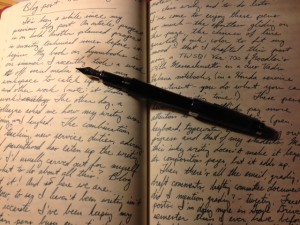#amnotwriting
It’s been a while since my previous blog post. An article project is on hold. Another planned project is awaiting technical issues before it begins. My book on hymnbooks is on simmer. I recently took a week off social media to clear my workspace to catch up on grading and other work (it didn’t work). The other day, a colleague asked me how my writing was going. I laughed.
The combination of teaching, new service duties, advising, and parenthood has eaten up the writing time I’d usually carved out for myself. So what to do about all this? Blog about it! And here we are.
Now, to say I haven’t been writing isn’t entirely accurate. I’ve been keeping my fountain pens busy generating teaching notes, meeting notes, brainstorming, in-class writing, and to-do lists. I’ve come to enjoy these pens so much—the effortless gliding on the page, the choices of line quality and ink color to fit my mood—that I drafted this post using a TWSBI Vac-700 and Noodler’s 54th Massachusetts blue ink in a Quo Vadis Habana notebook (in a Honda service department—you do what you can to find writing time!). Most of this inky writing doesn’t make it beyond the page on which it’s composed, but it adds up.
Then there’s all the email, grading, draft comments, drafting committee documents—did I mention grading?—tweeting, Facebook posts. I’m doing more in Google Drive this semester than I ever have before. I taught myself to make a timeline in Dipity and Timeline.js. I’ve made screencasts and audio mini-lectures for my course websites. It’s hard to get all this to add up to a page count, and it pushes the envelope as to what counts as writing.
As all this suggests, I’ve been thinking a lot about writing lately. Moving forward, I’m interested in ways to expand and revise my writing methods, especially through means that let me use my iPad and paper & ink more extensively.
This blog post is a new experiment along these lines; while I’ve become accustomed to drafting on paper this year, I’m trying out a new app, Phraseology, to transcribe this post. This app has gotten some good buzz online, and I was particularly attracted to its streamlined layout and its analysis features (thus far, I’ve written 385 words at a 7.5 grade level). I also tried out Scrivener, a Mac OS/Windows app that uses robust file management and outlining tools to make it easier to work on complex writing projects in pieces. This was a very helpful program for working through competing emphases for a talk I gave this semester (ha! there’s some writing). I’ve since moved my on-hold article manuscript from Word into Scrivener, and I now think I will write my next book in Scrivener.
And I’m thinking a lot about the teaching of writing as well. I’m developing a new course next semester on spiritual writing. We’ll be doing lots of journaling and revising in the course, using Thoreau as one of our guides—between his journals from the pond and the final version of Walden, Thoreau spent ten years revising the book; seven intermediate drafts survive. We’ll be writing about spiritual traditions, learning to draw, and other topics, using a range of writing modalities (pens will feature somewhere in there). The inspiration for this course comes from a seminar called “Contemplative Reading” I took in college with Dr. Marilyn Chandler McEntyre. That course taught me how to see anew through contemplative practice, and I hope I share that gift with my students through the context of writing.
My work on this course has been bringing me back repeatedly to the question of how much work the students should be producing—and by extension, how much I should be producing. I should mention that my tenure case will be decided this year, and that threshold has also spurred reflection on what kind of productivity I want to have. And I’ve found that I do want to write, every day, if I can manage it. But I’m also less interested in producing finished texts on deadlines, even internal ones, than I ever have been before. A wave of bloggers has recently taken up the subject of overwork in the academy and beyond. With more ways to do more than ever before, we continually do too much. All the kinds of writing I’ve been doing are an index of how much and how many kinds of work I’m doing. And it’s all too much.
I recently got to meet a scholar I’ve admired since graduate school, someone who followed up an influential first book with an influential edited collection. We talked about the experience of writing the second book, and how important it is to take a long time to do that. While the slower pace of producing the second book has caused concern in some circles, this scholar explained to me her own realization that she wanted to enjoy her family before the kids were grown, and that she wanted to enjoy her work, and that keeping up the pre-tenure pace would never allow for those things. We owe it to ourselves, our families, our students, our careers, to slow down.
So I’m not writing much these days. Not really. And that will get me ready for writing more lately—I hope at a livable pace.


I like Scrivener, too. But without ipad support, I’m still looking around. Great blog post. Thanks!